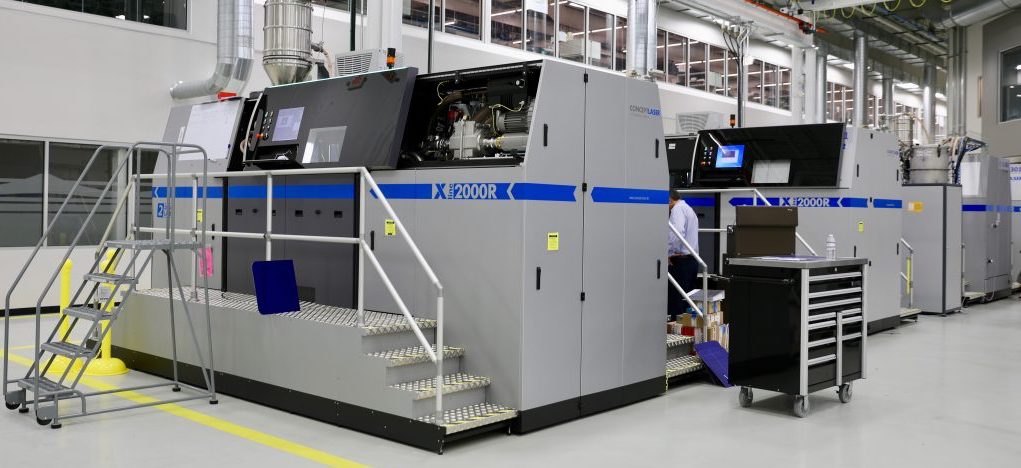

3D-PRINTING PLANT DEMONSTRATES ITS METAL
Silicon Valley gets a lot of attention for innovation, but another big piece of the future is currently taking shape in an otherwise nondescript, low, gray building along I-75 north of Cincinnati — the location of GE’s Additive Technology Center, one of the most advanced 3D-printing facilities in the world. Additive manufacturing, also known as 3D printing, lets engineers design and print metal parts directly from a computer file, reducing waste and enabling some truly complex creations. For instance, with the GE Catalyst — the company’s newest turboprop engine — designers combined more than 800 parts into about 12, reducing weight, simplifying maintenance and the supply chain, reducing weight and improving the engine’s performance.
A new way of printing yields a new way of working: As big as three football fields, the ATC was designed to be a melting pot that places manufacturing and supply-chain engineers in the same quarters as the technicians printing their designs, as well as those responsible for building the printers themselves. “This is a new industry,” said Eric Gatlin, general manager for GE Aviation focused on additive manufacturing. “You’ve got people who have come from a variety of backgrounds and have had to resculpt their thinking and learn new engineering practices. We wanted to create a learning environment because there’s no playbook for this.”
Read more about 3D-printed parts in jet engines, and the industrial partners GE engaged to make it all happen, here.
WIND, SOLAR — WHY NOT BOTH?
With 1.3 billion people, India is pivoting hard toward renewable energy. The country has set an ambitious goal to generate 40 percent of its energy from non-fossil-fuel sources by 2030. But an earlier milepost comes in 2022, when India is aiming for 175 gigawatts in installed renewables — more than double what it’s getting today. The country will rely heavily on wind and solar to meet these needs, and this renewable future will be supplied, in part, by a new hybrid plant: a combination wind-solar farm located in the rocky countryside just four hours from India’s tech capital, Bangalore, and operated by Atria Power with an assist from GE’s India Technology Center.
Two birds with one power plant: The farm offers a new solution to an old problem in renewables — the sun doesn’t always shine and the wind doesn’t always blow. In fact, wind turbines in this part of the southeast of India generate 70 percent of their annual output in just five months during monsoon season. Meanwhile, at times in the dry season, the area enjoys up to 10 hours of sunshine a day. “We realized that if we put together wind and solar power, the two energy sources can be very complementary,” said Anand Lahoti, Atria’s chief operating officer.
Find out how GE engineers helped Atria design the ultimate renewable two-fer here.
THIS VERTICAL FARM’S AMBITIONS ARE SKY-HIGH
Vertical farms are often touted as a way to feed a growing global population. These futuristic food factories provide bug-free, weather-proof environments for maximum output. Now, at Stockbridge Technology Centre in North Yorkshire, England, scientists are taking this idea a step further. Among other technologies, STC’s new Vertical Farming Development Facility uses innovative lighting — provided by Current, powered by GE — to supercharge its harvest.
Light wave of the future: The Arize Lynk LEDs designed by Current, which GE plans to sell to the New York-based private equity firm American Industrial Partners, play a leading role in the plants’ development by optimizing light waves to meet the needs of individual crops. In essence, STC’s scientists can mix and match different colors: Red light is favored by fruits and flowers, for instance, while blues encourage the growth of organic matter — such as in dense, compact heads of lettuce. “Vertical farming is in its infancy,” said Emma Moreau Bouché, growth leader at Current, “and it is going to revolutionize food security and innovation in produce.”
In addition to improving crop yield and quality, STC plans to experiment with pharmaceutical plants. Learn more here.
COOLEST THINGS ON EARTH ?
1. Lab-Grown Brains Make Waves
Scientists at the University of California, San Diego, have created brain “organoids” in the lab that spontaneously generated brain waves similar to those seen in premature babies. The project could lead to a better understanding of neurological development — and also brings up some interesting ethical questions.
2. Superwood As Strong As Steel
Engineers at the University of Maryland designed a “superwood” so strong that it could compete with steel as a material in cars, buildings and airplanes — it can even stop a speeding bullet. They created it by removing a polymer from regular wood that strengthens cell walls, then heating the wood and compressing it. The method also raises the possibility of strengthening softer, more environmentally friendly woods like balsa while sparing old-growth hardwood trees.
3. The Quickest Thinkers In The World
In the ongoing international competition for who can make the fastest computer, the United States recently nudged ahead of rivals including China, Japan and Switzerland. The world’s quickest-thinking machine, named Summit, was built at Oak Ridge National Laboratory in Tennessee, and the second-quickest machine was American, too.
Read more about this week’s Coolest Things on Earth here.
— QUOTE OF THE DAY —
“One of the things we are pushing now is: How do we make the assets sweat? How do we use them to the maximum?”
— Anand Lahoti, chief operating officer at Atria Power
Quote: GE Reports. Image: GE Reports
ENJOY THIS NEWSLETTER?
Please send it to your friends and let them know they can subscribe here.




